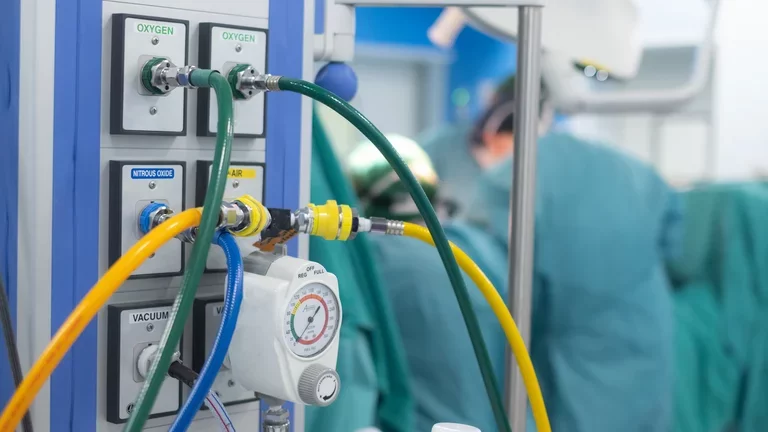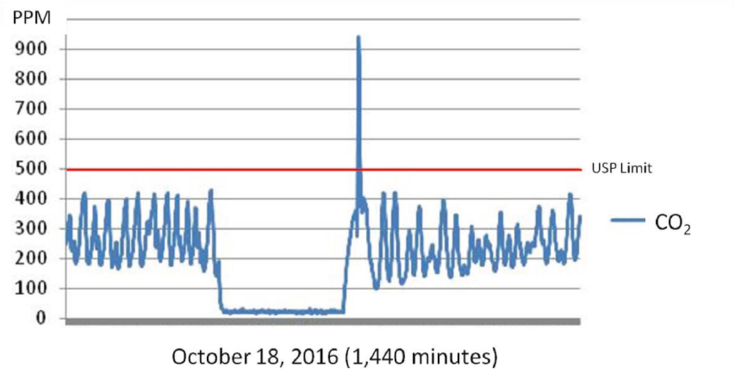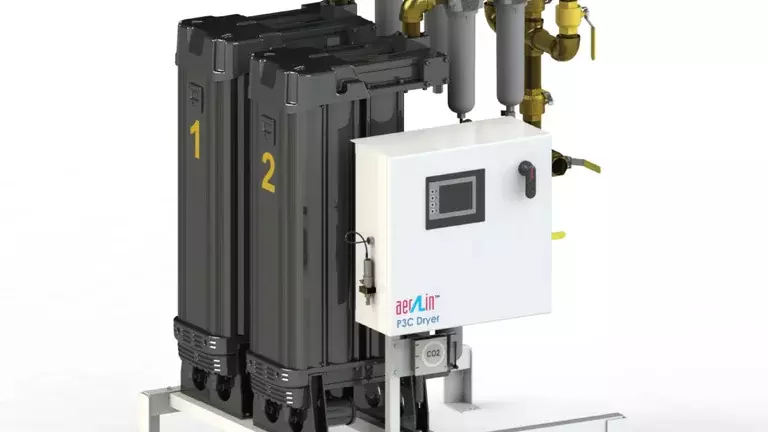Medical Air: What you don’t know won’t hurt you, but what about your patients?
Medical Air is a therapeutic product made on-site by most hospitals. Like all drugs, it must follow a formula.
Published on June 01, 2022
5 minutes

Medical Air is dispensed daily from thousands of wall outlets in Canadian hospitals.
In locations treating high acuity respiratory patients, the use of Medical Air rivals—and often eclipses—oxygen. Most hospitals with centrally piped Medical Air make the product onsite by compressing outdoor air.
As an RRT responsible for ventilation, high flow therapy, isolette environment control, or aerosol therapies, have you ever wondered about the quality of air issued from the wall outlets?
Health Canada deems Medical Air as a Schedule E drug, and the Canadian Building Code mandates that when made onsite at hospitals, “the health care facility shall ensure that the product produced by the Medical Air supply system and delivered to the pipeline distribution system meets the specifications for Medical Air USP or another monograph(s) as specified by the health care facility formulary” (CAN/CSA Z7396.1–17, 5.5.2.1.3).
A report produced by Air Liquide Healthcare describes findings from Medical Air quality sampling that began in February 2014 and now has over 60,000,000 chemical analysis data points collected from Medical Air source systems at major urban and remote rural sites. Through this data, we've learned that every site studied experienced USP formula breaches.
Sampled product has revealed CO levels above 50 ppm; more than five times the USP limit. And elevated levels of CO2 , often exceeding the USP limit by a factor of two, is by far the most common problem.
We have found that as we share evidence of quality problems with RRTs across the country, local stories of potential Medical Air quality breaches come to the surface. Staff from two sites with a level III NICU reported worrisome CO levels in patient arterial blood gas samples. In both cases, site personnel deemed the most plausible root cause to be high CO in centrally piped Medical Air. At sites with measured CO breaches, the root causes range from hospital boiler exhaust to idling diesel engine emissions that contaminate the air purity.
With CO2 being the most prevalent off-specification contaminant, special attention must be paid to this known asphyxiant.
Exposure to concentrations of >8% CO2 or more can cause death, unconsciousness, or convulsions. In terms of human physiology, we also know that normal CO2 levels in blood are essential to pH regulation and alveolar gas exchange. From a therapeutic perspective, in small controlled doses CO2 is an effective respiratory stimulant.
What we did not know until recently is that typical dryers used in hospital production of Medical Air are catching and releasing CO2 boluses into the pipeline. Figure 1 below illustrates the variability of CO2 measured through one day at a major urban facility with a mid-day bolus release.
Knowing that CO2 is a “sticky” molecule (i.e., higher density than oxygen or nitrogen), we wondered how far a bolus could travel intact through a pipeline? Further study confirmed a 1 L release of CO2 can travel beyond a kilometre within a half-inch copper pipeline and cause an oxygen deficient atmosphere (i.e., O2 < 18% volume/volume percent) upon exiting. The bolus depicted in Figure 1 above occurred after a brief shutdown and restart of the Medical Air plant. The sudden spike in CO2 lasted a few minutes and very likely resulted in oxygen deficient Medical Air at one or more wall outlets.
What does this all mean for clinicians?
With consideration of this emerging evidence, the authors of Canada’s medical gas piping regulation published a new requirement in 2017 (CSA Z7396.1, s5.5.2.1.5 (b)) that involves clinicians. Moving forward, when a Medical Air system is installed, modified, or replaced at a health care facility, a quality risk assessment must be performed to determine that the frequency of quality monitoring and control is appropriate, given the site-specific therapeutic applications involving Medical Air.
Clinicians must also take part in the assessment and be prepared to answer questions like:
- Are short-term bursts of oxygen deficient and CO2-laden Medical Air safe for your patients?
- Should your site’s Medical Air production system be designed to automatically prevent high levels of CO or CO2 from entering the pipeline?
In conclusion, Medical Air is a therapeutic product made on-site by most hospitals. Like all drugs, it must follow a formula. Canadian hospitals can choose the USP formula, or devise their own. USP lists six contaminants: carbon monoxide, carbon dioxide, humidity, nitric oxide, nitrogen dioxide, and sulphur dioxide. Are there other contaminants you would like measured and controlled, such as ozone? And what threshold limits for each contaminant make sense for your patients?
The evidence and regulations say it’s time for Respiratory Therapists to know and enforce the Medical Air formula at their hospitals!
References
2. Health Canada Drug Data Base.
3. Canadian Standards Association. 2017. Z7396.1-17 – Medical gas pipeline systems – Part 1: Pipelines for medical gases, medical vacuum, medical support gases, and anaesthetic gas scavenging systems. (CAN/CSA Z7396.1).
4. Medical air: A risk assessment
5. Edwards P, Therriault P, Katz I. Onsite production of medical air: Is purity a problem?
6. Rice S. Human health risk assessment of CO2: Survivors of acute high level exposure and populations sensitive to prolonged low-level exposure. 2004.
7. Edwards P., Assessing the quality of on site medical air. IFHE Digest 2018.
Do you need pricing or more information?
Our team will listen to your needs and answer your questions, to help identify the right equipment and services for your facility.
Write us
Talk to us
Visit us
6990 Creditview Road, Unit 6
Mississauga, ON L5N 8R9
-
Medical Air: What you don’t know won’t hurt you, but what about your patients?
Download the document PDF (760.21 KB) -
Medical Air: Whitepaper
Download the document PDF (1.08 MB) -
Medical Air: A Risk Assessment
Download the document PDF (1.39 MB) -
Onsite production of medical air: Is purity a problem?
Download the document PDF (692.94 KB) -
The day Edmonton went dark: Preparing for CO level spikes during emergencies
Download the document PDF (292.15 KB)








